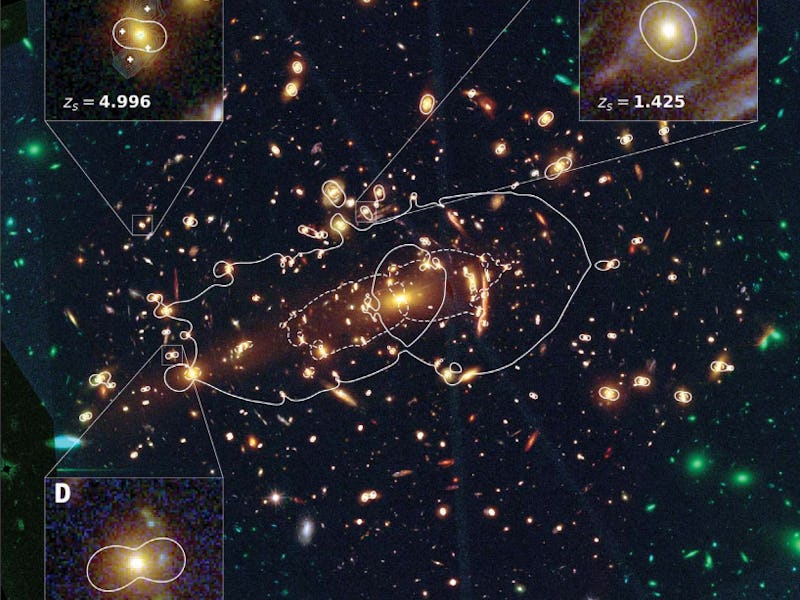Dark matter study challenges scientists' models of the universe
For cosmology, it may be back to the drawing board.

A few decades ago, astronomers realized they had a problem: They could not find enough matter in the universe to account for all the space in between stars and galaxies.
The missing mass begged the question: What holds all these cosmic bodies together through gravitational force?
This missing mass became known as dark matter, and it is theorized to make up most of the universe. Normal matter, the stuff we can find, only accounts for about five percent of the larger cosmos, so the theory goes. But since its discovery, dark matter has never been directly observed because it's, well, dark.
Now, using a technique known as gravitational lensing, a team of astronomers observed the small-scale distribution of cold dark matter within galaxy clusters. What they found could change current numerical models of the universe entirely.
The findings are detailed in a study published Thursday in the journal Science.
Astronomers looked through gravitational lenses to detect the elusive dark matter in massive galaxy clusters.
Massimo Meneghetti, a researcher at the Astrophysics and Space Science Observatory of Bologna, and lead author of the new study, sought out to test the standard model of galaxy clusters and compare it with what was happening in the real universe.
"We were trying to understand what we assumed would be the standard model, and see if we were able to find a match between what the model was predicting between the mass function and the distribution," Meneghetti tells Inverse.
To do that, the researchers mapped the distribution of matter in a total of 11 galaxy clusters using gravitational lensing.
Dark matter cannot be observed directly. So to detect its properties, astronomers have had to get creative. Gravitational lensing uses the light being emitted by a distant source in the universe as a lens, with the light becoming distorted as a result of the distribution of matter between the source and the object it is traveling towards.
"You can use this kind of effect to trace back the matter that you don't see," Meneghetti says.
The study measured dark matter subhalos, or smaller clumps of dark matter that make up large halos of dark matter. These halos create envelopes in which stars are confined.
Using the gravitational lens, the team of researchers were surprised to find several strong effects of dark matter that they were not able to simulate in numerical models of the universe. The lensing effect showed that the distribution of matter within the galaxy clusters was much more highly concentrated than the models had predicted.
"It’s not a matter of the number or the mass of these subhalos, it’s a matter of how concentrated they are," Meneghetti says. "They exceeded this critical value of density by a factor of 10."
The results could mean that the models are either not taking into account some unknown physical property related to star formation, or how ordinary matter and dark matter interact with each other. But another option is that the very nature of dark matter has not been fully understood.
"What we learned from this result is that there is something of the real universe that our current theoretical models cannot reproduce," Meneghetti says. "In order to solve this puzzle, we really need to explore some options that were never accounted for before."
The team of researchers is planning on gathering more data from the galaxy clusters in order to investigate their results further, and find out why it does not match up with current simulations.
Abstract: Cold dark matter (CDM) constitutes most of the matter in the Universe. The interplay between dark and luminous matter in dense cosmic environments, such as galaxy clusters, is studied theoretically using cosmological simulations. Observations of gravitational lensing are used to characterize the properties of substructures—the small-scale distribution of dark matter—in clusters. We derive a metric, the probability of strong lensing events produced by dark-matter substructure, and compute it for 11 galaxy clusters. The observed cluster substructures are more efficient lenses than predicted by CDM simulations, by more than an order of magnitude. We suggest that systematic issues with simulations or incorrect assumptions about the properties of dark matter could explain our results.
This article was originally published on